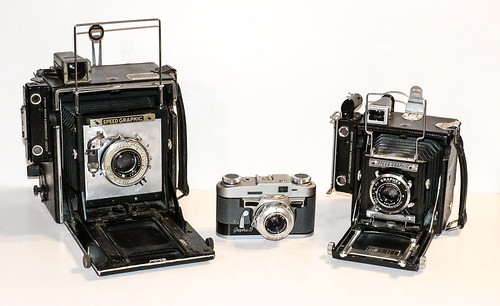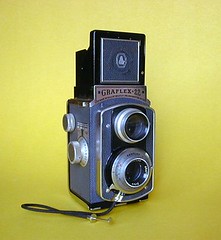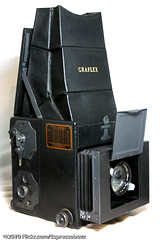Difference between revisions of "Graflex"
(→Sheet Film Cameras) |
|||
| Line 15: | Line 15: | ||
==Company== | ==Company== | ||
{{Rochester}} | {{Rochester}} | ||
| − | + | Graflex Inc. was a camera builder based in New York, starting in NYC, but being based in Rochester for much of its history. They produced professional medium and large format cameras, and consumer medium and small format cameras. | |
| + | {{brl}} | ||
| + | ==History== | ||
| + | Graflex Inc. began its life as the [[Folmer & Schwing]] company, of New York City. William F. Folmer was a serial inventor, and went into business with William E. Schwing. Their company originally produced gas lamps, but expanded into bicycles and photographic equipment, later focusing on cameras exclusively; after introducing their focal plane camera in 1899. <ref> Schilling, Donovan (2015). Made in Rochester. Victor, NY: Pancoast Publishing. p. 76. ISBN 978-0983849667. Retrieved 30 January 2016.</ref> With their success, they would eventually be bought out by [[George Eastman]], and integrated into [[Kodak]] as the "Folmer Graflex division of Eastman Kodak." By 1921, Kodak had become a monopoly on the sale of cameras in the United States, and was forced to divest itself of several assets, including Folmer Graflex. <ref> United States v. Eastman Kodak Co., 226 F. 62 (W.D.N.Y.1915) appeal dismissed, 255 U.S. 578, 41 S. Ct. 321, 65 L. Ed. 795 (1921).</ref> Failing to find a buyer, the company was spun off as '''Folmer Graflex Corporation''' in 1928. In 1945 it was renamed to '''Graflex Inc.''' . From the depression of the 1930s to 1957 the company grew from 100 to 760 employees. The company remained independent until 1958, when it was bought by '''General Precision''' before being sold to '''Singer Corp.''' in 1968. By the 1970's, much of the consumer camera products had been discontinued due to Japanese imports, and with the shift towards 35mm and 120 SLR's in the professional market, Graflex's historical professional customer base had largely eroded. In 1976 [[Cambo]] purchased the complete tooling, know-how and production of the [[Graflex XL]] camera from Singer Educational Systems, and marketed a slightly updated version as the [[Cambo XL]] for a time.<ref>British journal of photography - Volume 123 (1976), p. 575</ref> Rights to the 4x5 Speed Graphic and Crown Graphic were bought by the Japanese manufacturer of [[Toyo]] view cameras around the same time.<ref>Journal of the Biological Photographic Association, Volume 45 (1977) p. 24</ref> | ||
| − | |||
==Cameras from Graflex and its predecessor [[Folmer & Schwing]]== | ==Cameras from Graflex and its predecessor [[Folmer & Schwing]]== | ||
{{Flickr_image | {{Flickr_image | ||
Revision as of 16:49, 30 June 2020

|
| The "Graphic" Gang image by Neal Wellons (Image rights) |
The name Graflex may mean either:
- The main camera brand used by Folmer & Schwing, and (after 1905) the Folmer & Schwing division of Kodak
- The company that succeeded Folmer & Schwing when it had to be sold by Kodak in 1926
Contents
Company
| photography related industry in Rochester (New York) |
| American Camera | Bausch & Lomb | Blair | Century | Crown Optical Co. | Elgeet | Folmer & Schwing | Gassner and Marx | Graflex | Gundlach | Ilex | JML | Kodak | Milburn | Monroe | PMC | Ray | Reichenbach, Morey and Will | Rochester Camera and Supply Co. | Rochester Optical Co. | Rochester Panoramic Camera Co. | Seneca | Sunart | Walker | Webster Industries | Wollensak |
| and in Rochester (Minnesota) |
| Conley |
| external links |
| graflex.org - Rudolf Kingslake's "Optical industry in Rochester (N.Y.)" |
Graflex Inc. was a camera builder based in New York, starting in NYC, but being based in Rochester for much of its history. They produced professional medium and large format cameras, and consumer medium and small format cameras.
History
Graflex Inc. began its life as the Folmer & Schwing company, of New York City. William F. Folmer was a serial inventor, and went into business with William E. Schwing. Their company originally produced gas lamps, but expanded into bicycles and photographic equipment, later focusing on cameras exclusively; after introducing their focal plane camera in 1899. [1] With their success, they would eventually be bought out by George Eastman, and integrated into Kodak as the "Folmer Graflex division of Eastman Kodak." By 1921, Kodak had become a monopoly on the sale of cameras in the United States, and was forced to divest itself of several assets, including Folmer Graflex. [2] Failing to find a buyer, the company was spun off as Folmer Graflex Corporation in 1928. In 1945 it was renamed to Graflex Inc. . From the depression of the 1930s to 1957 the company grew from 100 to 760 employees. The company remained independent until 1958, when it was bought by General Precision before being sold to Singer Corp. in 1968. By the 1970's, much of the consumer camera products had been discontinued due to Japanese imports, and with the shift towards 35mm and 120 SLR's in the professional market, Graflex's historical professional customer base had largely eroded. In 1976 Cambo purchased the complete tooling, know-how and production of the Graflex XL camera from Singer Educational Systems, and marketed a slightly updated version as the Cambo XL for a time.[3] Rights to the 4x5 Speed Graphic and Crown Graphic were bought by the Japanese manufacturer of Toyo view cameras around the same time.[4]
Cameras from Graflex and its predecessor Folmer & Schwing

|
| Graflex 22 TLR image by Bill Strong (Image rights) |
35mm Film
- Graflex Ciro 35
- Graflex Graphic 35
- Graflex Graphic 35 Jet
- Graflex Century 35
- Graflex Century 35A
- Graflex Century 35NE
- Graflex Stereo Graphic (see also Wray Stereo Graphic)
- Graphic 35 Electric (name variant of the Iloca Electric)
- Graflex Photorecord
Medium Format Rollfilm
- Graphic 0
- 1A Graflex
- 3A Graflex
- National Graflex
- Graflex 22
- Combat Graphic
- Graflex XL
- Graflex Norita

|
| Auto Graflex showing typical style of early Graflex SLRs image by EspressoBuzz (Image rights) |
Sheet Film Cameras
- Auto Graflex - 3¼×4¼, 4x5 SLR
- Revolving Back Auto Graflex - Drop bed 3¼×4¼, 4x5 SlR
- Stereo Auto Graflex - 3¼×5½ Stereo Pair SLR
- Auto Graflex Junior - 2¼x3¼ SLR
- Compact Graflex - 3¼×5½ SLR
- Naturalist Graflex - Telephoto 4x5 SLR
- Home Portrait Graflex - 5x7 SLR
- Press Graflex - 5x7 SLR
- Graflex Series B - 2¼x3¼, 3¼×4¼, 4x5, 5x7 SLR
- Graflex Series C - 3¼×4¼ SLR
- Graflex Series D - 3¼×4¼, 4x5 SLR
- Graflex Super D - 3¼×4¼, 4x5 SLR
- Graflex reflex models
- Graflex Fingerprint Camera - 2¼x3¼ Forensic Camera
- Graflex Speed Graphic (Super, Super Speed, Pacemaker Speed, Pacemaker Crown and Century Graphic)
- Crown View
- Graphic View cameras
- Super Speed Graphic
- Graflex XL

|
| Super Speed Graphic image by rawheadrex (Image rights) |
Aerial Cameras
The K20, and perhaps others, were designed by Fairchild, and so may also be known as Fairchild K20.
- Folmer Graflex K20 Aircraft Camera
- Folmer Graflex K21 Aircraft Camera
- Folmer Graflex K25 Aircraft Camera
Notes
- ↑ Schilling, Donovan (2015). Made in Rochester. Victor, NY: Pancoast Publishing. p. 76. ISBN 978-0983849667. Retrieved 30 January 2016.
- ↑ United States v. Eastman Kodak Co., 226 F. 62 (W.D.N.Y.1915) appeal dismissed, 255 U.S. 578, 41 S. Ct. 321, 65 L. Ed. 795 (1921).
- ↑ British journal of photography - Volume 123 (1976), p. 575
- ↑ Journal of the Biological Photographic Association, Volume 45 (1977) p. 24
Links
- www.graflex.org resource site, especially for Crown and Speed Graphics
- Documents at Mike Butkus' Orphan Cameras:
- PDF manuals
- Catalogs (1920 - 1980s) showing pricing of various Graflex cameras when released.
- Graphic 35mm camera PDF manuals from OrphanCameras.com
- learn more about personalising the Speed Graphic camera with extreme lenses
- Complete Graflex camera listing with detailed info at Historic Camera
- Graflex Cameras Price Guide at CollectiBlend
- Cameras and User manuals at www.collection-appareils.fr (in French)